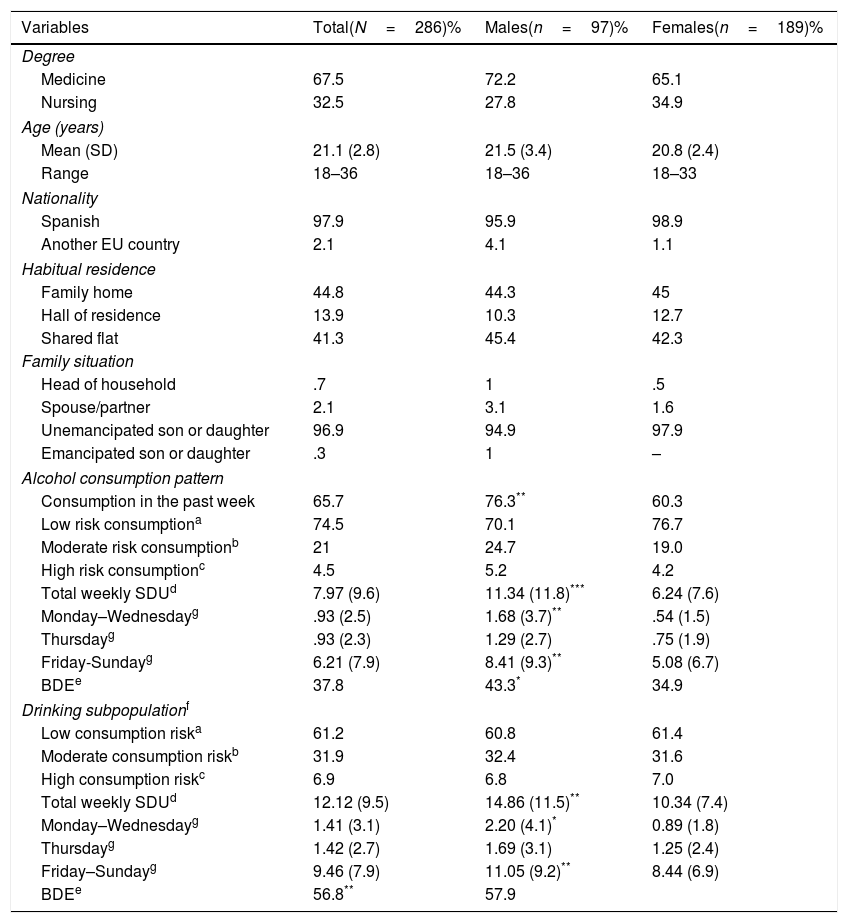To describe the alcohol drinking patterns and binge drinking episodes (BDE) in a sample of Health Science students, as well as identify associated factors.
MethodIt is a descriptive study, in which sociodemographic variables and a weekly alcohol consumption diary recording the number of standard drinking units consumed at different times of the day are collected by means of a self-administered questionnaire.
Results286 students (66.1% women) from Cadiz University (193 Medical students and 93 Nursing students), with a mean age of 21.1 (SD 2.8) years, took part in this study. Forty-four point 8percent of the students live with their families. Sixty-five point 7percent of the students drank alcohol in the previous week, this was more usual in the males. The weekly alcohol consumption pattern was 74.5% for low-risk alcohol consumption, 21% for moderate-risk and 4.5% for a high-risk consumption. Thirty-three point 9percent had 1–2 BDE over the previous week apart from their weekly consumption pattern. Twenty-six point 6percent of the students who were emancipated had moderate-risk consumption, 8.2% had a high-risk consumption and 41.8% had a binge drinking episode. There were statistically significant associations between the weekly consumption pattern regarding sex, habitual residence and BDE variables.
ConclusionsMore than half the students had taken alcohol the previous week, mainly at weekends. The high prevalence of BDE is highlighted. We propose enhancing early detection and prevention campaigns in this population.
Describir los patrones de consumo de alcohol y de episodios de consumo intensivo (ECI) en una muestra de estudiantes de Ciencias de la Salud, así como identificar factores asociados.
MétodoEstudio descriptivo que mediante cuestionario autoadministrado recoge variables sociodemográficas y el diario consumo de alcohol, registrando el número de unidades de bebida estándar consumidas en varios momentos del día.
ResultadosParticiparon 286 estudiantes (66,1% mujeres) pertenecientes a la Universidad de Cádiz (193 Medicina y 93 Enfermería), con una edad media de 21,1 años (DE 2,8). El 44,8% vive en domicilio familiar. El 65,7% consumió alcohol en la última semana, siendo más frecuente en varones. El patrón de consumo semanal fue del 74,5% para consumo de riesgo bajo, 21% riesgo moderado y 4,5% riesgo elevado. Un 33,9% tuvo entre 1-2 ECI en la última semana, apareciendo estos independientemente del patrón de consumo semanal. De los alumnos que residen fuera del domicilio familiar, un 26,6% tuvieron un consumo de riesgo moderado, un 8,2% riesgo elevado y un 41,8% ECI. Se evidencian asociaciones estadísticamente significativas entre el consumo semanal de alcohol y las variables sexo, domicilio habitual y ECI.
ConclusionesMás de la mitad de los estudiantes consumió alcohol en la última semana, con un consumo mayoritariamente de fin de semana, destacando la alta prevalencia de ECI. Se propone incidir en la detección precoz y campañas en estos grupos.








